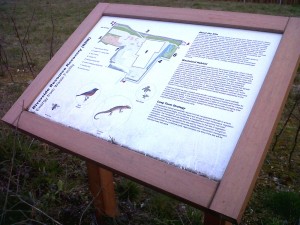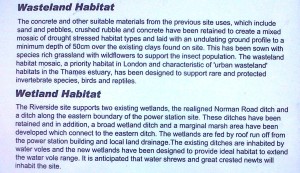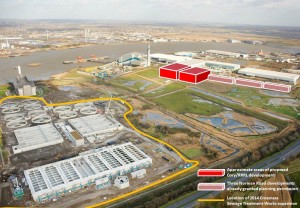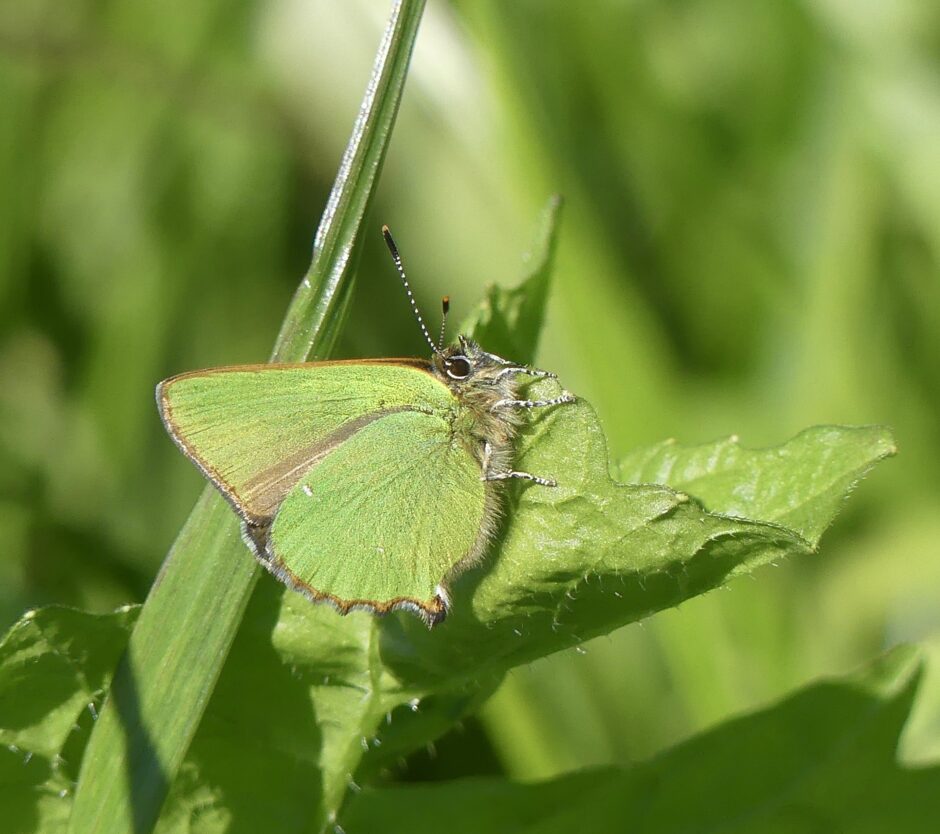Cory ‘Environmental’, the company that has submitted to Bexley Council – in the name of its Belvedere incinerator arm – a plan for two four-storey buildings to cover most of the former Borax fields next to Crossness Nature Reserve, has not even bothered to check for the presence of scarce Great Crested Newts and Water Shrews, which its own long-standing signboards claim may colonise the area.

One of the public information signboards by Belvedere incinerator, attempting to extoll the ‘virtues’ of the site for wildlife. (Photo: Chris Rose)
‘BW’ has previously drawn attention to the woeful inadequacy of the ‘ecological survey’ of the fields as a whole, which was funded by the company as part of the formal planning application. In addition to the above-mentioned ‘flaw’, it was only done on one day in each of September and October, and failed to mention that the fields are a breeding site for two species of red-listed birds and another that breeds nowhere else in Bexley, despite this information being in the public domain.
Now the reality is that the Great Crested Newt, which has some degree of legal protection, is something of a poster species for conservation, in that a lot of the public have heard about issues around destruction of its habitat for ‘development’, but it is only recorded from the south of the Borough, way down beyond the Sidcup railway line, and would have huge trouble finding a safe point at which to get across the A2. The Water Shrew is very rare in London and is going to suffer similarly from fragmented habitat. Indeed according to the London biodiversity records centre (GiGL) there are no records from Bexley, with the nearest having been made 11 years ago at Ruxley Gravel Pits. The chances of either species turning up in the ditch and pool created next to the incinerator – in order to try and give it some ‘green’ credentials – are therefore slim to non-existent, as anyone bothered to study the Borough’s wildlife would quickly conclude.

Great Crested Newts, Water Shrews? We think not. Overblown claims do not enhance credibility. And nor, now, do statements about the importance of mosaic habitat when your own survey admits a large area of it will be completely destroyed if your planning application for the nearby Borax fields is approved ….. (Photo: Chris Rose)
But if you’re going to make extravagant public claims of this sort you should still make the effort to check to at least try and appear to be consistent and honest. There are established survey methods for GCN, including bottle trapping, night-time torching and now even DNA analysis of pond water. None of these were done. Surveying for presence of Water Shrews can involve live trapping, analysing droppings from tubes baited with food, and by using tubes that ‘capture’ hair samples. None of this was done either.
The boards also imply that Common Lizards will be present around the incinerator. Grass Snake is already known to inhabit the adjacent Crossness Nature Reserve. No tins, felts or other credible reptile survey work was done to check for Common Lizard or Slow Worm, despite these species being legally protected from deliberate killing or injury, which ‘development’ operations would be taken to have inflicted if no prior survey, capture and removal had been done. A single Grass Snake was seen in the affected area, but only through a casual and rather fortuitous observation.
Moreover despite the report stating that
‘The flower rich habitats [of the fields] have the potential to support range of invertebrate species that would be more conspicuous during the spring and summer months. The possibility that the site supports an invertebrate assemblage of conservation significance exists given the flower rich and bare ground habitats present, and the sites location.’
the survey was wholly inadequate to determine whether the nationally extremely rare Shrill Carder Bee, known to be present on Crossness NR, uses the fields, as seems quite likely.

Aerial image showing the huge cumulative impact of recent and projected ‘development’ on what little is/was left of Erith Marshes. The two buildings proposed by Cory will take up most of both of the Borax fields and will be four storeys high, much taller than nearby warehousing.
Readers may wish to decide for themselves whether what’s on these ‘information’ boards is cynical propaganda or just down to plain stupidity, and whether the lamentable inadequacies of the ecological survey are down to arrogance (the company assuming Bexley Council will just wave the application through anyway?) or incompetence.
Chris Rose. Vice-chair, Bexley Natural Environment Forum.

Very welcome campaign (demonstration) and some beautiful photographs on http://thethamesmeadgrump.blogspot.co.uk/
Several years ago whilst we were fighting development plans for Southmere Green (now Veridian Park) we had quite a few sightings of grass snake and slow worm. We did a lot of work to find Great Crested Newt in the ditches..Sadly not successfully. Loads of Palmate and Common newts. Additionally there were some exotic snake species appearing now and then. American rat snakes were fairly regularly seen or captured. The principal headline species on the Green at the time (98-06) were skylarks and water voles which the prospective developer at first refused to recognise as their own eco-surveyor had not seen them on the one day he had actually visited the place. Nothing appears to change in the world of developers does it?.
Interesting. I’m on the RRR Forum and know nothing of this.
I don’t know what’s left there now but as a child I found newts frogs toads voles eels leeches and kestrels in that area….I was told there were rabbits and weasels but never saw them
..